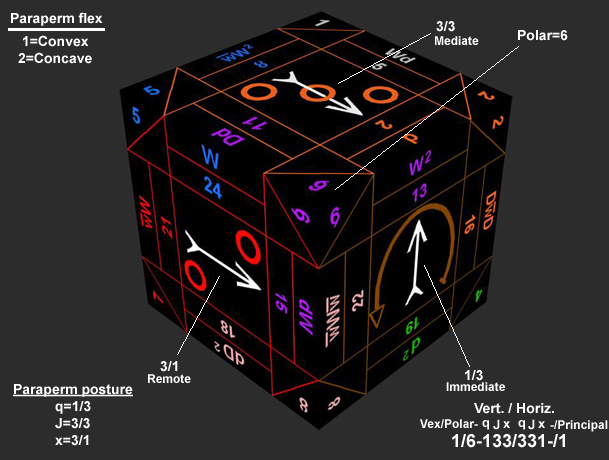The previous illustrated table of paraperms shows the polar and principle information for all 48 exact faces of the tablocks, but in order to encompass the flex and postural information the paraperms must be expanded. Take for example Upright U Vex(#13),which has a paraperm of 1-6 expanded to its form 123-212.

By expansion, this is expressed as 1/6-133/331-/1, which is parsed as follows: 1/6 means 1=does not change the flex (it remains a Convex face), 6=the polar component of the immediate face (212=yin yang yin). The posture sequence is next. It describes the postures of the Immediate, Mediate and Remote faces of the current toperm (236). The first number before the / describes the vertical posture, the second number after the / is the description of the horizontal posture. In short: V/H. The four postures are numbered as: 1=Upright, 2=Prone, 3=Averse and 4=Supine. Hence, the postural portion is: 133/331 or, as it is broken down in the q,J,x order: 1/3(q), 3/3(J), 3/1(x). Note the opposing V/H postures (1/3 and 3/1) of both the female q and x faces here on the Convex tablock.
If we examine this postural sequence carefully, the female Salt (q) face of Upright U is a vertical of 1 (no change to Upright),and horizontal of 3 (reverse or Averse a horizontal posture)=(1/3). For the Male Quicksilver (J) face of Averse I, the vertical is 3 and likewise the horizontal is 3 (Averse)=(3/3). And lastly for the female Sulphur face of Averse E, the vertical is 3 (Averse) and the horizontal is 1 (no change to a horizontal)=(3/1).

As noted briefly above, the vertical or horizontal posture function of each face in the expanded paraperm is determined by the following rule: When there is a disparity between the sex of the face and flex of the tablock (e.g. a female face such as U, O or E on the *male* Convex tablock, or conversely with male faces on the *female* Concave tablock), the V/H posture numbers are reciprocal (e.g. 1/3 or 2/4 for instance). This means the posture of a female face on the Vex tablock (or a male face on the Cave tablock) is taken from the Vertical portion of its posture function (the number before the /). In addition, when there is parity between sex of the face and flex of the tablock, the V/H posture numbers are identical (e.g. 1/1, 2/2, 3/3 or 4/4). In other words, in instances of parity between sex and flex, the posture be may derived from either side of the V/H posture function since they are identical. The image below is highlighted in yellow to demonstrate the non-parity posture rule between sex of the face and tablock flex.

As noted before, the expanded paraperms and their posture functions should be worked through & verified with your own set of tablocks.